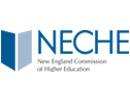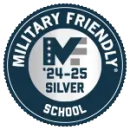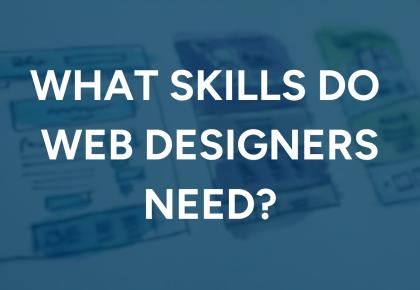Take CMIT-135,WEBD-125 and WEBD-220 or CYBR-210
Spring term A begins. Apply by Jan. 1.
Spring Term B begins. Apply by Feb. 26.
Summer Term A begins. Apply by April 23.
Explore Web Design & Development
Capitalize on the growing demand for web designers and developers with an integrated degree online web development degree. Champlain's bachelor's in web design and development degree will give you the tools you need to marry creative design with back-end programming, and give you the confidence to launch or advance your career in this dynamic field.
Learn how to finish your program faster with credit for prior learning and experience.
Build Your Career Future
With an integrated approach that encompasses all aspects of the field, including programming, design, e-commerce, and infrastructure, our online web development degree will help you build key technical skills (including knowledge of over 32 key applications, platforms, and programming languages, listed below) in addition to in-demand soft skills such as problem-solving and communication. You'll also have the opportunity to differentiate your web design and development degree and gain subject matter expertise through a certificate in a specialization of your choice in Web Design or Web Programming, just work with your advisor to learn how. With a foundation of business savvy and subject matter expertise, you'll be prepared to tackle new and emerging trends in the field.
Program Curriculum
Learn more about Champlain's 100% online web design & development bachelor's degree, designed for working professionals.
Champlain's online web development degree courses encompass the top skills needed by today's web professionals. Graduates of the online web development degree program are required to complete the following courses.
Professional Courses (60 credits)
Technical Electives (6 credits)
General Education Courses (42 credits)
General Electives (12 credits)
Note: Some of the courses in this program are available in 15-week terms only. Please contact your advisor for details.
Understanding financial statements and how to interpret them is important to all those working in businesses. In this course students learn the relationship among financial statements; study how to interpret this information and to apply this understanding in real-world contexts; and learn how to use financial information to help make sound management decisions.
This course provides students with an understanding of the many different devices and technologies, from historical to emerging, that are required to design and build networks. In a broad survey of concepts and terminology, students will learn about topology, communications, protocols, and security, and to diagram basic networks to specification.
From day one, students in this course are problem solving, first in terms of algorithmic design and then as early as week two via programming in the latest version of Python, using PyCharm. Students begin by writing a program to have a conversation, having strings and numbers as input, and advance, by week seven, to building a working password saver program, capable of looking up, adding (and encrypting), and storing passwords.
This course, through guided research and hands-on learning experiences, provides students with an understanding of operating systems, including their core fundamental principles and how they work. Students are introduced to the three most popular operating systems for personal computers (Windows, OSX and Linux), and mobile operating systems, and learn about standard functions such as memory, process/thread, input/output, storage and device management.
Learn the basics and more in this course on Relational Database Management Systems (RDBMS) and SQL (Structured Query Language). Students propose a final project in the first module and then work, week-by-week, to design, create, and populate the database. Then, students learn to create queries and stored procedures.
This is a course on how to find and exploit vulnerabilities in systems. While discussing the ethical and legal framework of these activities, students will use Google search techniques (a.k.a. Google Hacking), online applications, including Damn Vulnerable Web Application (DVWA), and Champlain’s virtual environments equipped with Kali Linux, Metasploitable, Nessus, Nexpose, NMAP, Zed Attack Proxy (ZAP), W3AF, Burp, and Security Administrator Tool for Analyzing Networks (a.k.a. SATAN), among other tools.
Prerequisites
Project Management is the formal application of knowledge, skills, tools, and techniques to project-based activities to meet organizational requirements. Project management is accomplished through the use of processes such as Initiating, Planning, Executing, Monitoring and Controlling, and Closing. Project managers can divide projects into these phases to provide better management control with appropriate links to the ongoing operations of the organization. Collectively, these phases, known as the project life cycle, form the foundation for the practice of project management and are guided by the Body of Knowledge from the Project Management Institute (PMI).
This course introduces the core terminology and principles of marketing. Students learn about the marketing mix (product, price, place, and promotion), market segmentation, and how external factors such as the economy, technology, culture, and competition influence marketing decisions. The course also examines how marketing fits within an organization and contributes to business success, along with how ethical considerations, cultural awareness, global trends, and social responsibility shape marketing practices across industries. No prior business experience is required.
This course will provide an overview of digital marketing strategies and techniques for organizations operating in a digital environment. Students will learn about consumer behavior in digital spaces as well as tactics including search engine optimization (SEO), pay-per-click (PPC) advertising, email marketing, social media and content marketing and analytics. Students will apply what they learn to the development of a digital audit and recommendations project for an organization. Additionally, students will earn several industry certifications as part of their coursework.
Prerequisites
MKTG-115
Today's high-quality digital images are as much art as they are science. In this course, students learn to use Adobe Photoshop to prepare and create images for web use. Hands-on activities develop familiarity with tools like eyedropper and quick mask, but also challenge students to create vector shapes and incorporate typography into the design of an ebook cover. Students also must create an email campaign and redesign a web site to specifications.
From storyboard to form creation, students walk through the steps to create a basic four to five-page website to specification in this course that introduces HTML5 and CSS. Hands-on assignments reinforce skills development and best practices in design: navigation, column layout, image editing and usage, fonts and tables.
Great websites are created with specific audiences in mind and are the culmination of a process that includes creating messaging and developing a strategy that maps out the best content and functionality to reach the audience and influence its behavior. In this course, students begin with a SWOT analysis and development of a mission statement, and then create a sitemap and content, before publishing a website and blog.
Websites must balance technology with aesthetics. In this course, students study web design patterns and personas, and then create a wireframe storyboard with at least four panels designed for a standard desktop view. Students use Mockups 3.
Prerequisites
Complete MKCM-102 or WEBD-125
This course examines web servers from the page "in" rather than website design, which is from the page "out". Students learn the differences between TCP and UDP, gain an understanding of XML, and build a use case for a course enrollment system. Hands-on labs allow students to use ping and traceroute, and create XAMPP alias directories.
Complex web page designs fully utilized all the functionality provided by the browser. In this course, students complete a variety of hands-on assignments as part of a redesign of an existing site. One week they recreate a page using appropriate HTML5 tags, while in another they implement drag and drop functionality that must work when the site is displayed in the Chrome browser. Later in the course, students animate transitions and build a basic responsive version of the site.
Prerequisites
WEBD-125
Students who want to build database-driven or interactive web sites benefit from this course which covers PHP and MySQL along with how to build sites that incorporate authentication and security. Each week hands-on assignments are used to reinforce concepts. Students advance from an introduction to PHP and basic syntax, to handling user input and manipulating arrays in web forms to queries.
Prerequisites
WEBD-125, CMIT-200
Hands-on learning begins in week one when students must create a Pen in CodePen before they can submit a short program written in Javascript and continues through the final project in which students produce a web application that contains specific elements. Functions, objects, and events, but also DOM (Document Object Model), AJAX (Asynchronous Javascript and XML), and JSON (Javascript Object Notation), are presented in this course.
Prerequisites
WEBD-225, CMIT-135
Time to take a website to the next level? Just add audio and video to make it media-rich. First, though, take this course to learn how to utilize Bootstrap and recognize good use of responsive design. Then, create or implement animation using tools such as CSS3 Animation, Web Animations API or HTML5.
Prerequisites
WEBD-110, WEBD-225, WEBD-330
Websites have three functions - to facilitate, enable and persuade - and are only useful if they can connect people and achieve definite goals. In this course, students learn to understand the concept of usability, and the roles of interaction, users, communication and collaboration as well as how to evaluate usability, and observe and test users.
Prerequisites
WEBD-215 OR SDEV-230
Students will be challenged to showcase new and previously acquired web design and development knowledge and skills in this scenario-based course meant to simulate the start-to-finish process of working with a client to build and deliver a fully-featured web site. Students will utilize written and oral communication, content creation, programming and database management skill sets in this 15-week practicum.
Prerequisites
Must have completed 90 credits.
In addition to the following courses, please complete one 3-credit General Education Elective by choosing a course from the following:
- ARTS
- COMM
- CRIM (except CRIM 225)
- CRIT
- ENGL
- HIST
- MATH
- MKCM 120
- PHIL
- PSYC
- SOCI
This course introduces students to the foundational concepts needed to communicate effectively in writing for academic study and professional development. Students will also learn to read critically to evaluate an author's message. Students will be introduced to rhetorical modes and their role in the development of written communication. Students will also learn how to use revision strategies to create written communication that meets its intended purpose for its intended audience
This course builds on students' proficiency in the writing process and rhetorical modes to introduce the use of sources in written communication. Students will practice information literacy as they learn to determine information needs from sources, develop effective search strategies, and incorporate sources in written communication, legally and ethically.
Prerequisites
Complete ENGL-100
Starting with a frame of human communication as a dynamic system of interactions in which people make choices that impact their relationships, other people, and themselves, students will define theory-informed communication concepts and processes, and critically examine how they apply to everyday life across a variety of contexts. Students will reflect on how the theory, concepts and processes apply to their own lives in becoming competent communicators who are knowledgeable, skilled, and versatile.
This course examines the principles of effective small group interaction. Students will analyze group development stages and small group roles. They will identify and evaluate communication skills that enhance small group cohesion and problem-solving. Students will explain how conflict affects group processes and compare face-to-face versus digital collaboration environments. These skills prepare students to participate effectively in group settings across academic, professional, and community contexts.
Students will learn and apply critical inquiry skills to analyze persuasive communication created by others and to develop persuasive communication/arguments of their own to solve problems in professional, civic, social, and personal contexts. Specifically, students will learn to recognize fallacies in logic; apply inductive and deductive reasoning strategies to the interpretation and development of persuasive communication; evaluate the validity of sources; and develop logically sound persuasive communication. Students will explore the roles of self-awareness, empathy, and ethics in the context of critical inquiry and the development of arguments.
Prerequisites
Complete ENGL-110.
This course is an historical overview, and examination of the evolution of digital, film, and print media, and their functions. Students will identify and analyze contemporary problems of the media such as the legal, social, economic and psychological implications of their relationships with society. They also will examine the ways in which marketing and PR professionals utilize the mass media channels to reach their intended target audiences.
This course explores the complex and evolving relationship between human beings and technology. Through a multi-disciplinary approach that draws on fields such as sociology, psychology, philosophy, and history, students will examine the ways in which technology has shaped human culture, identity, and values, as well as how humans have influenced and continue to influence the development, adoption and use of technology.
Mathematical reasoning, when applied to everyday and professional lives, has two dimensions: logic for deterministic situations and probabilities for non-deterministic situations. This course aims to help students develop these mathematical reasoning skills.
This course introduces students to basic statistics for data literacy. With a focus on exploring real-world data, students will interpret numerical information and utilize the tools necessary to complete the entire statistical process: designing a study; gathering, organizing, and analyzing sample data; and making inferences about a population. Students will demonstrate data-driven decision-making and effective communication of numerical data.
This course covers the fundamental concepts of linear algebra and analytical geometry, including matrices, vectors, linear transformations, and systems of linear equations. Students will also explore the analytical geometry of Euclidean spaces, including lines, planes, circles, spheres, and conic sections. In this course, students will develop their mathematical reasoning skills and learn how to apply these principles to solve real-world problems.
Introduces students to the biochemistry and physiology of nutrition and exercise. Emphasis will be placed on human body systems such as musculoskeletal, digestive, respiratory and circulatory, and their relationship to nutrition and fitness. Students will also study the biochemistry of energy conversion as it relates to exercise physiology. Laboratory sessions are designed to reinforce, by a hands-on approach, the principles discussed in lecture. Course includes two laboratory hours per week.
Students will develop the ability to apply scientific methods to understand the natural world, to identify scientific aspects of daily life, and to evaluate the quality of scientific information based on its source and the methods used for its generation.
In this course, students will gain an introduction to classical mechanics and learn about motion, force, energy, and momentum. The course covers vectors, scalars, and coordinate systems, as well as kinematics in one and two dimensions, Newton's Laws of Motion, circular motion, and kinetic energy and work. Students also learn about potential energy and energy conservation, collision theory, rotational motion, moment of inertia, torque, rotational dynamics, and angular momentum.
This course will introduce students to major streams of social justice thought, including historical social justice movements, theoretical problems having to do with social equality, personal freedom, marginalization, and stigmatization, and the ways in which civic and professional communities respond to these issues.
With pressure and release, a window opens and closes, recording light on a sensor. The simple action captures the instinct, judgement, and skill of the person behind the lens. This class will begin a study of the art and craft of photography. Students will develop their vision and their understanding of how to achieve it. Solid skills will be learned and many doors will be opened.
A survey of the continuing change experienced in art since the 15th century. Students will examine how an image is achieved as well as the significance of the subject represented. Individual inquiry concerning the nature of art is encouraged.
Students learn to appreciate films through the critical analysis of various elements of mise-en-scene, cinematography, editing and sound. The course introduces the conventions of classical Hollywood cinema, considers the work of one major director (auteur), and surveys selected international and independent films. Students view and discuss films each week.
Students in the course will explore the cultural history of the music genre broadly referred to as rock. Students will explore the social, economic and political contexts that are influenced by and that influenced each style in the United States. By listening, watching, reflecting upon, discussing and writing, students will explore how music takes on meaning, personally, and culturally. Topics and themes include the relationships between and among gospel, country, funk, folk, disco, rap and hip hop; the role of business and technology in those relationships, and political or transgressive elements of rock music.
Specific application of common tools for writing in the working world. Students will be instructed in rhetorical strategies of professional writing including style, report formats, editing, document design, and integration of visual aids. Students will complete a semester-long writing project; oral and written reports associated with the process of problem-solving within the project will be included.
Prerequisites
ENGL-112 or COR-125
Students will learn effective workplace negotiation skills and strategies that they can apply in a wide variety of business contexts including operations, business development, sales, and client relations. Students will explore the negotiation process, including identifying the objectives, challenges and motivations of each party, the various transactional structures that can achieve each party's objectives and the ethical, professional, political, and social issues that can arise in a business negotiation.
In this course, students will explore and apply writing principles and techniques to effectively interpret and write technical workplace materials. Students will enhance and gain skills to communicate business and technical information by producing instructions, describing processes, applying document design elements, creating and integrating illustrations, researching and writing proposals and formal reports, and presenting content for decision-makers.
This course introduces students to the fundamentals of substantive criminal law. With this foundation for understanding the legal system students will identify the essential elements of crimes, including the criminal act, criminal state of mind, and jurisdiction. They will examine the rationale underlying criminal law, factors affecting criminal responsibility, and legal defenses. By analyzing real-world scenarios, students will develop skills to distinguish lawful from unlawful actions and prepare for advanced studies or careers in criminal justice.
This course focuses on the rules and procedures governing how the American criminal justice system must process individuals suspected, accused, and convicted of law violations.
In this course, students will explore the theory and fundamentals of criminal investigation, emphasizing practical applications for evidence handling and case development. Students will review basic responsibilities of investigators and protocols for report writing, evidence collection, and preparation of cases for trial. The curriculum examines investigative approaches for various crime categories, including violent offenses, property crimes, terrorism, and hate crimes, while introducing comparative perspectives from diverse legal systems.
Prerequisites
Take CRIM-120.
Principles of Economics introduces the fundamental concepts of economics - the study of how people manage resources, and how they react to scarcity. This course focuses on both microeconomics (the behavior of consumers and companies) and macroeconomics (large-scale economic factors such as employment and interest rates), so that you'll gain a broad understanding of how a modern market economy functions, how decisions in business settings are informed by economics, and how economics applies to your everyday life.
Students will study important themes in the social history of the United States since the Civil War. This course allows students to expand their critical thinking skills through an examination of primary and secondary sources. Themes might include: the evolving status of women; the immigrant experience; the concept of the American dream; the paradox of freedom vs. slavery; the minority experience; the tensions between social classes. Students will be evaluated primarily on writing assignments.
In this course, students will explore broad, foundational knowledge in psychology, including its history, major theorists and a survey of psychology subfields such as developmental, cognitive and social psychology. Students will also describe and assess the role of ethics and social responsibility in the study and application of psychological theory and practices.
In this class, students will explore how social relationships, groups, societies and culture develop and change over time. From a sociological theory foundation and employing the sociological imagination, students will examine the impact of social structures, institutions, and systems on individual lives. Students will apply sociological research methods to investigate sociological phenomena in their own lives.
Additional Program Details
Graduates of the web design & development bachelor's online program will demonstrate the following industry-specific skills, knowledge, and competencies:
- Apply industry-standard best practices and strategies to design visually compelling and functionally efficient web interfaces on all screen sizes.
- Develop interactive and dynamic websites using both client-side and server-side programming languages, ensuring responsive and engaging user experiences.
- Integrate diverse media elements, including graphics, text, audio, and video, to enhance web content and deliver immersive digital experiences.
- Utilize version control and collaborative development tools to manage code repositories and facilitate web projects.
- Evaluate and optimize website usability and accessibility for all users to ensure alignment with user experience (UX) principles and regulatory standards.
- Build comprehensive web development projects by synthesizing multiple technologies and frameworks, demonstrating mastery in content management, scripting, and design.
- Utilize marketing practices to ensure websites effectively meet audience needs and business objectives
Earn a specialized certificate in a concentration of your choice as you pursue your degree, so you can build credentials as you go. Speak with your academic advisor as soon as you can, they can help get you on the proper pathway to reach your goal.
- Adobe Photoshop
- AJAX (Asynchronous Javascript and XML)
- Bootstrap
- Burp
- CodePen
- CSS
- CSS3 Animation
- Damn Vulnerable Web Application (DVWA)
- DOM (Document Object Model)
- Google Hacking
- HTML5
- Javascript
- JSON (JavaScript Object Notation)
- Kali Linux
- Metasploitable
- Mockups 3
- MySQL
- Nessus
- Nexpose
- NMAP
- PHP
- Ping
- Security Administrator Tool for Analyzing Networks (SATAN)
- TCP
- traceroute
- UDP
- VMware
- W3AF
- Web Animations API
- XAMPP
- XML
- Zed Attack Proxy (ZAP)
Our admissions team seeks to admit students who:
- Demonstrate a solid academic foundation - a minimum 2.5 GPA is our recommendation, though exceptions may be made on a case-by-case basis for those who demonstrate a potential for academic success in other ways.
- Possess an aptitude for success in an online learning environment.
- Exhibit the ability to make a positive contribution to the Champlain College Online community.
To learn more about submitting transcripts, or requirements for home-schooled students, those educated abroad or returning students visit our Undergraduate Admissions page.
Our transfer credit evaluation team works hard to ensure you get the transfer credits you deserve, from a variety of sources including prior college credits, work experience and training, military training and experience, and more. Our goal is to help you graduate from Champlain College Online as quickly and affordably as possible. Visit our Transfer Credit Options page to learn more.
Champlain College Online's web design & development faculty, led by Program Director Richard Pickering, are expert practitioners in the field. Their industry expertise ensures that our web development curriculum is aligned with the needs of employers, and reflects the skills today’s web design & development professionals need for success. Classes led by our seasoned experts will give you real-world insight into the field, and create a rich community of career-focused learning.
Tuition & Costs
Online Undergraduate Tuition Fall '25 - Summer '26
* Alumni is defined, for this tuition rate, as any degree program graduate from Champlain College or Champlain College Online.
** Veteran rate effective Spring 2025, not retroactive
See the undergraduate cost of attendance and fees here
Affordability and Paying For Your Education
We provide a number of options to make your online education affordable, including preferred tuition for alumni, associate degree graduates, community college graduates, and military.
What Can You Do With a Web Design & Development Degree?
Web development careers are expected to grow 13% between 2020 and 2030, much faster than the average for all occupations. The median annual salary for web developers is $77,200.*
The high demand for web design and development services across the business world means that job opportunities are available in virtually any industry, including computer systems design, creative services, finance and insurance, education, and nonprofits.
*Source: Bureau of Labor Statistics (BLS), 2020; job titles: ComputerScience.org, 2020
Top Jobs for Bachelor's in Web Design & Development Graduates
- Computer Programmer
- Front End Developer
- Web Developer
- Web Designer
- UX Designer

Why Champlain
Online Experience
"Studying at Champlain Online was a long-sought opportunity for me to get a formal and complete education in IT. I appreciated the school's virtual environment, and the small class sizes allowed better and easier interaction with the professors."

Academic Excellence and Recognition

Regionally accredited by the New England Commission of Higher Education

Designated as a Military Friendly School for our commitment to the military community
Ranked among the best by Tech Guide for game design and computer science

Named the among the best schools with accelerated bachelor's degrees by Intelligent.com
Meet the Program Director
Daniel Selicaro, MS
- Computer Science (BS)
- Software Development (AS, BS)
- Web Design & Development (AS, BS)
- Software Engineering and Project Management (MS)
About
Daniel Selicaro is an Assistant Professor and Program Director for Technology at Champlain College Online. He oversees bachelor degree programs for Software Development, Web Design and Development, and Computer Science, as well as the graduate program in Software Engineering and Project Management.
Dan has been at Champlain College since 2007, and has been teaching web design and development for Champlain since 2015. He began his career in print journalism as a newspaper reporter, and was the news editor for Upside magazine and the Red Herring magazine in California. After moving back to the East Coast, he worked on digital marketing at Champlain College, and was an active part of two redevelopments of the College website, champlain.edu, before he took a role in the Information Systems department.
Outside of Champlain, Dan runs his own website development company, and is on the board of directors for several local organizations — including as marketing chair at the Fellowship of the Wheel mountain biking club, the Green Mountain Montessori School, and the Essex United Soccer Club. He is an avid mountain biker, and loves to spend his time adventuring in Vermont with his two young children.

Frequently Asked Questions
Most online bachelor’s in web design & development programs require a high school diploma or GED. Having basic skills in computer usage, graphic design, or coding (HTML, CSS, JavaScript) can be helpful but is not always required.
Basic web design doesn’t always require coding, but knowing HTML, CSS, and JavaScript helps create and customize websites. For advanced features, coding is essential. Champlain College’s online BS in Web Design & Development covers those essential technical language proficiencies in flexible online learning format.
A web designer focuses on a website’s look and user experience (UI/UX, layout, graphics), while a web developer builds the functional backend using coding languages like HTML, CSS, JavaScript, and more. Through Champlain College’s online BS in Web Design & Development, you can gain the essential proficiencies in both areas to prepare for these exciting, cutting-edge fields.
The industry outlook for web designers is strong, with demand driven by the need for modern, user-friendly websites. The U.S. Bureau of Labor Statistics projects steady growth, especially for designers skilled in UI/UX, mobile-friendly design, and SEO. The BS in Web Design and Development at Champlain is delivered flexibly online and can give you the edge you need to compete in this in-demand job field.
You May Also Be Interested In
Get Your Web Design & Development Guide
Learn what you can expect from our online bachelor's in web design & development program.

Download Program Guide
I acknowledge that, by clicking the "submit" button, I am giving my express written consent to Champlain College and its representatives to contact me about educational opportunities via email, text, or phone, at the phone number above, including my mobile phone, using an automatic dialer, or pre-recorded message. Message and data rates may apply. I understand that my consent is not a requirement for enrollment, and I may withdraw my consent at any time.






